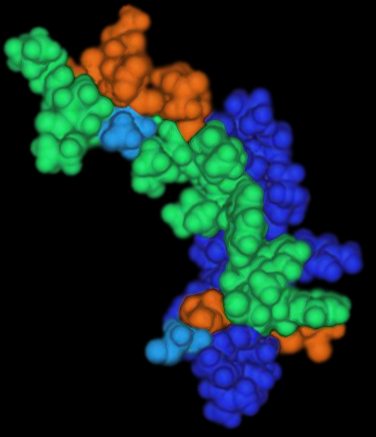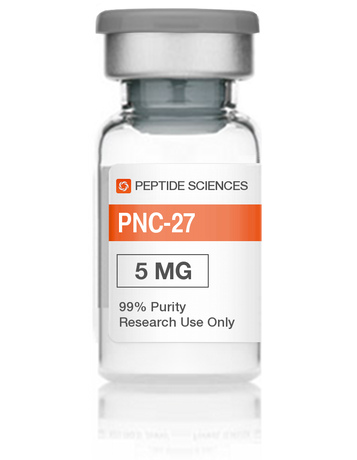What is PNC-27?
PNC-27 is a synthetically created peptide designed to specifically target and destroy cancer cells. It is part of a set of PNC research proteins designed to attach to ugly (cancerous) cells and cause them to die as a result of cell necrosis, while normal, healthy cells remain intact and whole and unharmed.
The PNC-27 peptide contains an HDM-2-binding domain corresponding to residues 12-26 of p53 and a transmembrane-penetrating domain. It was found that this allows the peptide to bind to and kill cancer cells through membranolysis, or cell membrane disruption.
Through research and animal studies, the PNC-27 peptide has shown high efficacy in selectively targeting a wide range of specific forms of cancer, including pancreatic cancer, breast cancer, leukemia, melanoma, and additional cancer lines.
PNC-27 peptide

Molecular formula : C188H293N53O44S
Molar mass : 4031.7
How does the PNC-27 peptide work?
PNC proteins were first theorized and created in 2000 by Drs. Matthew Pincus and Joseph Michl at SUNY Downstate Medical Center in New York. Although originally intended to fight HIV, PNC-27 has shown a remarkable ability to bind to cancer cells, causing them to die while leaving healthy cells unharmed.
The cancer peptide PNC-27 is a non-toxic compound that causes the death of only cancer cells, leaving all other healthy cells unchanged. This can be done by attaching to the membranes of individual cancer cells, creating holes in these membranes. As a result of the holes, a rapid implosion occurs, leading to rapid cell death due to the difference in osmotic pressure inside and outside the tumor cells.
PNC-27 does this through its ability to bind to a protein called HDM-2. Cancer cells have HDM-2 in their cell membranes. When the PNC-27 peptide is injected, it immediately moves to HDM-2 located in the cancer cell membranes. By binding to them, it creates pores or holes in the cell membrane, causing "membranolysis" or the death of the cell membrane. This in turn leads to the destruction of the cancer cell.
Clinical studies of the PNC-27 peptide
In a document published by the American Cancer Research Association in 2010, Dr. Ehsan Sarafraz-Yazdy et al. revealed in detail how the cancer peptide PNC-27 exerts its effects and what its new mechanism of action means for the field of cancer research. The authors of the article report that the mechanism of action of the peptide is due to the formation of oligomeric pores in the plasma membrane of tumor cells. At the same time, oligomeric pores are not formed in non-transformed or non-tumor cells. In addition, they noted that it was shown that MDM2 as a targeting molecule leads to the selectivity of PNC-27 in relation to cancer cells due to its incorrect localization on the plasma membranes of cancer cells cell.
The researchers concluded that these results describe the unique localization of MDM2 variants in the plasma membranes of cancer cells. [5] In addition, they stated that this knowledge may indicate great prospects for the PNC-27 peptide as a future anticancer drug awaiting clinical trials.
The research peptide PNC-27 was even the subject of a fascinating Ted Talk. This can be seen under the guidance of Dr. Sarafraz-Yazda, Associate Professor in the Department of Gynecologic Oncology at the State University of New York (SUNY).
Reviews of PNC-27 peptides
When the PNC-27 peptide is administered in animal studies, certain aspects are noted in the successful results. Researchers noted that subjective pain levels decrease in an average of one week. After 3 weeks, animals often develop flu-like symptoms, which is a likely indicator that the subjects' immune system is reacting to the death of cancer cells.
After 6 weeks, the levels of lactate dehydrogenase and bilirubin usually increase. Substantial destruction of the tumor in successful research results is often observed at about 10 weeks. At this time, the tumors become softer and more pliable.
At this time, some increase in the tumor itself can be noted. However, this is often associated with inflammation due to the reaction of the immune system. By the end of 3 months, researchers often notice that animal subjects show increased energy levels and a decrease in cancer-related symptoms.
PNC-27 side effects in studies
Side effects of PNC-27 have been observed in animal studies. These include inflammation of the skin and nose, tearing, dry skin, high blood pressure, headache, back pain, nosebleeds, rectal bleeding, change in taste, and too much protein in the urine.
PNC-27 Clinical trials
In a 2009 study, researchers found that the previously established three-dimensional structure of p53 PNC-27 residues was directly superimposed on the structure for the same residues associated with HDM-2. This led the researchers to conclude that PNC-27 can target HDM-2 in cancer cell membranes.
Notably, cancer cells have significant levels of HDM-2 in their membranes, while non-transformed or non-cancerous cells do not have significant levels of HDM-2. This allows the PNC-27 peptide to selectively target cancer cells while leaving healthy surrounding tissues intact.
After further experiments, it was found that by implanting non-transformed cells, not sensitive to PNC-27, with HDM-2, which contains a membrane localization signal, these cells then become sensitive to PNC-27. As a result, this became further evidence that the PNC-27 peptide is able to selectively target HDM-2 in the membranes of cancer cells and destroy them through membranolysis, leaving healthy cells without damaged.
In addition, in a study published in 2010 in the journal "Chemotherapy and Pharmacology of Cancer", researchers found that PNC-27 has a destructive effect on cancer cells in the form of a whole peptide, and not fragments.] Knowing that the peptide forms transmembrane pores in the cancer cell membrane, the researchers decided to determine whether these pores were created by parts of the peptide (fragments) or by itself peptide as a whole.
In the course of the experiment, it was shown that indeed the entire peptide exerts its influence on the cell membrane of cancer cells. In addition, it was noted that other non-transformed or non-cancerous cells around cancer cells "remain viable". From the results of the experiment, the researchers found out that the cancer peptide PNC-27 targeted specific markers in the membranes of cancer cells. , In addition, thanks to this mechanism of action, the service life of PNC-27 increases.
The PNC-27 peptide destroys cancer cells
In a 2006 study published in the International Journal of Cancer, researchers found that PNC-28, a precursor to the peptide PNC-27, which is very similar in structure and action, was able to selectively inhibit the growth of pancreatic cancer cells in vivo. The study observers noted that the peptide induced necrosis, but not apoptosis, in various tumor cell lines, including of a ras-transformed rat pancreatic cancer cell line known as BMRPA1. [4] In addition, the peptide had no effect on non-transformed (normal) cells. As a result, the researchers tried to determine whether the cancer-killing peptide could block the growth of pancreatic cancer cells in vivo.
Surprisingly, the researchers observed that when the cancer-killing peptide was injected, it caused a complete blockade of tumor growth during the 2-week administration period and the 2-week post-treatment period. This was followed by weak tumor growth that plateaued at small tumor sizes compared to tumor growth in the presence of the control peptide.
Furthermore, when the cancer-killing peptide PNC-27 was administered after tumor growth had occurred at a site distant from the tumor, the reduction in tumor size was accompanied by a slow increase in tumor growth that was "significantly slower than growth in the presence of controls". peptide ». Consequently, the researchers came to the conclusion that the cancer-killing peptide can be effective in the treatment of cancer, especially if it is injected directly into the tumor itself.
Studies of peptide peptides PNC-27
In a more recent study conducted in 2014 and published in the journal Annals of Clinical & Laboratory Science, the researchers came to the conclusion that the "anti-cancer peptide, PNC-27, induces tumor cell necrosis of a poorly differentiated solid tissue mammalian leukemia cell line, which depends on the expression of HDM-2 in the plasma membrane of these cells".
In essence, the researchers relied on knowledge obtained from earlier experiments that the PNC-27 peptide was able to destroy solid tissue tumor cells by binding to HDM-2 proteins in their cell membranes, an effect independent of p53 activity in these cells. The scientists sought to determine whether the PNC-27 peptide would be equally effective against non-solid tissue tumor cells.
This experiment would determine whether such non-solid tumor cells actually expressed HDM-2 in their membranes (as found in solid tissue cells) and would determine whether PNC-27 could induce cell death in these cells through the same HDM-2 binding mechanism.
Incredibly, it was observed that these non-solid tumor cells actually express HDM-2 in cell membranes. In addition, perhaps more importantly, it was found that the PNC-27 peptide can induce cell necrosis through membranolysis by the same HDM-2 binding mechanism as in solid tissue tumor cells, independent of the p53 pathway.




There are currently no reviews for this product.
Your review will be the first.
Tell other users of the site about the advantages and features of the product, share your impressions and expert opinion.